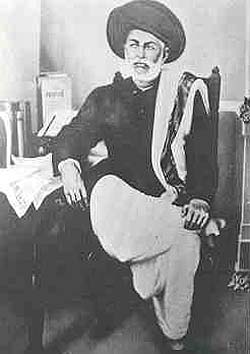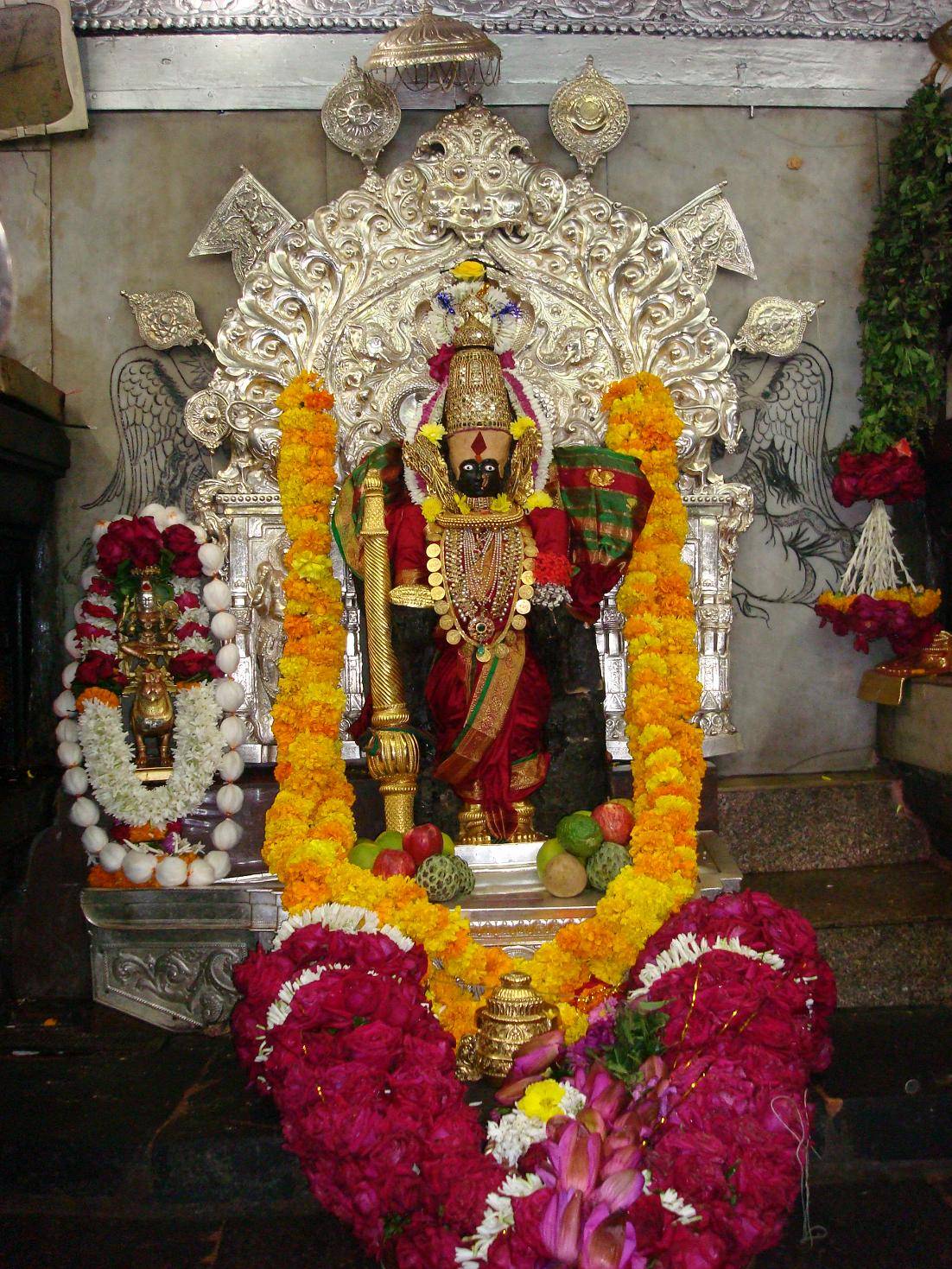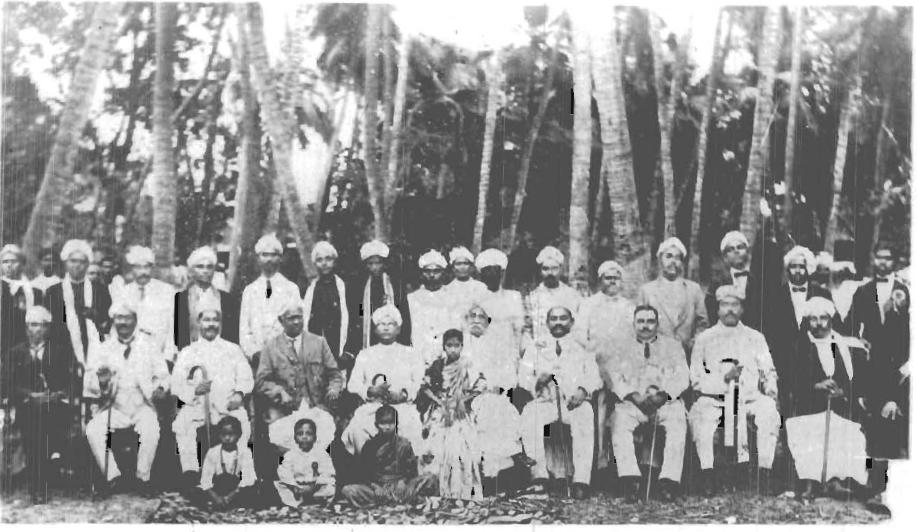|
Bhaskarrao Vithojirao Jadhav
Bhaskarrao Vithojirao Jadhav (17 June 1867 – 26 June 1950) was an Indian politician, social reformer, and leader of the Satyashodhak Samaj, Non-Brahmin movement and the co-operative movement. Bhaskarrao Jadhav started his career as an administrator in the Kolhapur princely state in 1895. He worked as the Superintendent or administrator of Kolhapur municipality from 1904 to 1918. Jadhav was nominated to the Bombay Legislative Council in 1922 and subsequently elected to the Council twice from Satara constituency in 1923 and 1926. Under the system of diarchy in Bombay Presidency, he served as a Minister of Education from 1923 to 1927 and Minister of Forest, Excise & Agriculture from 1928 to 1930. In 1930, he was elected to the Central Legislative Assembly. He represented the Justice Party at the Round Table Conference The three Round Table Conferences of 1930–1932 were a series of peace conferences organized by the British Government and Indian political personalities to d ... [...More Info...] [...Related Items...] OR: [Wikipedia] [Google] [Baidu] |
Satyashodhak Samaj
Satyashodhak Samaj (''Truth-seekers' Society'') was a social reform society founded by Jyotiba Phule in Pune, Maharashtra, on 24 September 1873. It espoused a mission of education and increased social rights and political access for underprivileged groups, focused especially on women, peasants, and Dalits, in Maharashtra.. Jyotirao's wife Savitribai was the head of women's section of the society. The Samaj disbanded during the 1930s as leaders left to join the Indian National Congress party. Early years Phule was born into a Mali family in 1827 and was educated at a Christian missionary school. After he completed his own education, he and his wife focused on expanding educational opportunities for low caste communities. The Protestant Christian tilt of Phule's education strongly affected the theoretical underpinnings of the Satyashodhak Samaj. The Satyashodhak movement espoused a framework that could be called religious. It emphasized the equality inherent in all men, as besto ... [...More Info...] [...Related Items...] OR: [Wikipedia] [Google] [Baidu] |
Kolhapur State
Kolhapur State or Kolhapur Kingdom (1710–1949) was a Maratha princely State of India, under the Deccan Division of the Bombay Presidency, and later the Deccan States Agency. It was considered the most important of the Maratha principalities with the others being Baroda State, Gwalior State and Indore State. Its rulers, of the Bhonsle dynasty, were entitled to a 19-gun salute – thus Kolhapur was also known as a 19-gun state. The state flag was a swallow-tailed saffron pennant. Kolhapur State, together with its ''jagirs'' or feudatory vassal estates (including Ichalkaranji Jagir, Ichalkaranji), covered an area of 3,165 square miles (8,200 km2). According to the 1901 census, the state population was 910,011, of which 54,373 resided in Kolhapur Town. In 1901, the state enjoyed an estimated revenue of £300,000. History The Maharajas of Kolhapur have a common ancestry with the Bhonsle dynasty of Satara State, Satara, being direct descendants of the Maratha King Shivaji ... [...More Info...] [...Related Items...] OR: [Wikipedia] [Google] [Baidu] |
Kolhapur
Kolhapur () is a city on the banks of the Panchganga River in the southern part of the Indian state of Maharashtra. It is the administrative headquarter of the Kolhapur district. In, around 2 C.E. Kolapur's name was 'Kuntal'. Kolhapur is known as ''`Dakshin Kashi''' or Kashi of the South because of its spiritual history and the antiquity of its shrine Mahalaxmi, better known as Ambabai. The region is known for the production of the famous hand-crafted and braided leather slippers called Kolhapuri chappal, which received the Geographical Indication designation in 2019. In Hindu mythology, the city is referred to as "''Karvir''." Before India became independent in 1947, Kolhapur was a princely state under the Bhosale Chhatrapati of the Maratha Empire. It is an important center for the Marathi film industry. Etymology Kolhapur is named after Kolhasur, a demon in Hindu History. According to History, the demon Kolhasur renounced asceticism after his sons were killed by God f ... [...More Info...] [...Related Items...] OR: [Wikipedia] [Google] [Baidu] |
Bombay Legislative Council
Bombay Legislative Council was the legislature of the Bombay Province and later the upper house of the bicameral legislature of Bombay Province in British India and the Indian state of Bombay. History The Indian Councils Act 1861 set up the Bombay Legislative Council as an advisory body through which the colonial administration obtained advice and assistance. The Act empowered the provincial Governor to nominate four non-English Indian members to the council for the first time. Under the Act, the nominated members were allowed to move their own bills and vote on bills introduced in the council. However, they were not allowed to question the executive, move resolutions or examine the budget and not interfere with the laws passed by the Central Legislature. The Governor was also the president of the Council and he had complete authority over when, where and how long to convene the Council and what to discuss. Two members of his Executive Council and the Advocate-General of Bombay w ... [...More Info...] [...Related Items...] OR: [Wikipedia] [Google] [Baidu] |
Satara District
Satara district (Marathi pronunciation: Help:IPA/Marathi, [saːt̪aɾaː]) is a Districts of Maharashtra, district of Maharashtra state in western India with an area of and a population of 3,003,741 of which 14.17% were urban (). Satara (city), Satara is the capital of the district and other major towns include Medha, Wai, Maharashtra, Wai, Karad, Koregaon, Man, Vikramgad, Maan, Koynanagar, Rahimatpur, Phaltan, Mahabaleshwar, Vaduj and Panchgani. This district comes under Pune Administrative Division along with Pune District, Pune, Sangli District, Sangli, Solapur District, Solapur and Kolhapur district, Kolhapur. The district of Pune District, Pune bounds it to the north, Raigad District, Raigad bounds it to the north-west, Solapur District, Solapur the east, Sangli District, Sangli to the south, and Ratnagiri District, Ratnagiri to the west. The Sahyadri, Sahyadri range, or main range of the Western Ghats, runs north and south along the western edge of the district, separating ... [...More Info...] [...Related Items...] OR: [Wikipedia] [Google] [Baidu] |
Diarchy In Bombay Presidency
Diarchy was established in Bombay Presidency based on the recommendations of the Montague-Chelmsford report. It ended with the election in 1937 when the Government of India Act 1935 came into effect. Government of India Act of 1919 Government of India Act of 1919 enlarged the provincial legislative councils and increased the strength of elected members to be greater than that of nominated and official members. It introduced a system of dyarchy in the Provinces. Although this Act brought about representative Government in India, the Governor was empowered with overriding powers. It classified the subjects as belonging to either the Centre or the Provinces. The Governor General could override any law passed by the Provincial councils. It brought about the concept of "Partial Responsible Government" in the provinces. Provincial subjects were divided into two categories - reserved and transferred. Education, Sanitation, Local self-government, Agriculture and Industries were listed as th ... [...More Info...] [...Related Items...] OR: [Wikipedia] [Google] [Baidu] |
Central Legislative Assembly
The Central Legislative Assembly was the lower house of the Imperial Legislative Council, the legislature of British India. It was created by the Government of India Act 1919, implementing the Montagu–Chelmsford Reforms. It was also sometimes called the Indian Legislative Assembly and the Imperial Legislative Assembly. The Council of State was the upper house of the legislature for India. As a result of Indian independence, the Legislative Assembly was dissolved on 14 August 1947 and its place taken by the Constituent Assembly of India and the Constituent Assembly of Pakistan. Composition The new Assembly was the lower house of a bicameral parliament, with a new Council of State as the upper house, reviewing legislation passed by the Assembly. However, both its powers and its electorate were limited. The Assembly had 145 members who were either nominated or indirectly elected from the provinces. The Legislative Assembly had no members from the princely states, as they we ... [...More Info...] [...Related Items...] OR: [Wikipedia] [Google] [Baidu] |
Justice Party (India)
The Justice Party, officially the South Indian Liberal Federation, was a political party in the Madras Presidency of British India. It was established on 20 November 1916 in Victoria Public Hall in Madras by Dr C. Natesa Mudaliar and co-founded by T. M. Nair, P. Theagaraya Chetty and Alamelu Mangai Thayarammal as a result of a series of non-Brahmin conferences and meetings in the presidency. Communal division between Brahmins and non-Brahmins began in the presidency during the late-19th and early-20th century, mainly due to caste prejudices and disproportionate Brahminical representation in government jobs. The Justice Party's foundation marked the culmination of several efforts to establish an organisation to represent the non-Brahmins in Madras and is seen as the start of the Dravidian Movement. During its early years, the party was involved in petitioning the imperial administrative bodies and British colonial officials demanding more representation for non-Brahmins in go ... [...More Info...] [...Related Items...] OR: [Wikipedia] [Google] [Baidu] |
Round Table Conferences (India)
The three Round Table Conferences of 1930–1932 were a series of peace conferences organized by the British Government and Indian political personalities to discuss constitutional reforms in India. These started in November 1930 and ended in December 1932. They were conducted as per the recommendation of Muhammad Ali Jinnah to Viceroy Lord Irwin and Prime Minister Ramsay MacDonald, and by the report submitted by the Simon Commission in May 1930. Demands for Swaraj or self-rule in India had been growing increasingly strong. B. R. Ambedkar, Jinnah, Sir Tej Bahadur Sapru, V. S. Srinivasa Sastri, Sir Muhammad Zafrulla Khan, K. T. Paul and Mirabehn were key participants from India. By the 1930s, many British politicians believed that India needed to move towards dominion status. However, there were significant disagreements between the Indian and the British political parties that the Conferences would not resolve. The key topic was about constitution and India which was mainly discu ... [...More Info...] [...Related Items...] OR: [Wikipedia] [Google] [Baidu] |
Bombay Presidency
The Bombay Presidency or Bombay Province, also called Bombay and Sind (1843–1936), was an administrative subdivision (province) of British India, with its capital in the city that came up over the seven islands of Bombay. The first mainland territory was acquired in the Konkan region with the Treaty of Bassein (1802). Mahabaleswar was the summer capital. The Bombay province has its beginnings in the city of Bombay that was leased in fee tail to the East India Company, via the Royal Charter of 27 March 1668 by King Charles II of England, who had in turn acquired Bombay on 11 May 1661, through the royal dowry of Catherine Braganza by way of his marriage treaty with the Portuguese princess, daughter of John IV of Portugal. The English East India Company transferred its Western India headquarters from Surat in the Gulf of Cambay after it was sacked, to the relatively safe Bombay Harbour in 1687. The province was brought under Direct rule along with other parts of British I ... [...More Info...] [...Related Items...] OR: [Wikipedia] [Google] [Baidu] |
Members Of The Bombay Legislative Council
Member may refer to: * Military jury, referred to as "Members" in military jargon * Element (mathematics), an object that belongs to a mathematical set * In object-oriented programming, a member of a class ** Field (computer science), entries in a database ** Member variable, a variable that is associated with a specific object * Limb (anatomy), an appendage of the human or animal body ** Euphemism for penis * Structural component of a truss, connected by nodes * User (computing), a person making use of a computing service, especially on the Internet * Member (geology), a component of a geological formation * Member of parliament * The Members, a British punk rock band * Meronymy, a semantic relationship in linguistics * Church membership, belonging to a local Christian congregation, a Christian denomination and the universal Church * Member, a participant in a club or learned society A learned society (; also learned academy, scholarly society, or academic association) is a ... [...More Info...] [...Related Items...] OR: [Wikipedia] [Google] [Baidu] |
People From Kolhapur
A person ( : people) is a being that has certain capacities or attributes such as reason, morality, consciousness or self-consciousness, and being a part of a culturally established form of social relations such as kinship, ownership of property, or legal responsibility. The defining features of personhood and, consequently, what makes a person count as a person, differ widely among cultures and contexts. In addition to the question of personhood, of what makes a being count as a person to begin with, there are further questions about personal identity and self: both about what makes any particular person that particular person instead of another, and about what makes a person at one time the same person as they were or will be at another time despite any intervening changes. The plural form "people" is often used to refer to an entire nation or ethnic group (as in "a people"), and this was the original meaning of the word; it subsequently acquired its use as a plural form of per ... [...More Info...] [...Related Items...] OR: [Wikipedia] [Google] [Baidu] |







_1938.jpg)